Outwitting History
by Aaron Lansky
[Book]

view/request
Outwitting History is an adventure tale, but much more than an adventure tale. It is a deeply felt, thoughtful look into the place of “other” cultures subsumed into the American melting pot, an homage to a generation that will soon be gone, and an homage to books. Yiddish may have outwitted history, but couldn’t have done it without Aaron Lansky. Share this story of the birth of one of our local institutions and the local hero who made it happen. Bring a tissue but be prepared to laugh.
Reviewed by Linda
Tagged: History, Local author, Local history, Non-fiction, Yiddish
A Woman of No Importance
by Sonia Purnell
[E-Audiobook]
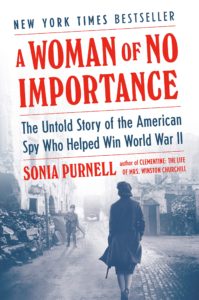
view/request
This biography of a completely unsung WWII heroine reads like a spy thriller. In spite of what seems today incredible discrimination because of her gender, American Virginia Hall was instrumental to the creation of various undercover operations in Nazi occupied France, working for the British long before the US entered the war. The danger of those operations, descriptions of the conditions for the civilian population, and of the torture to which suspected members of the Resistance were subjected are not sensationalized. The narrator, Julie Stevenson, does an admirable job of distinguishing between the various, largely male, characters. This title is recommended especially to fans of Susan Elia MacNeal’s Maggie Hope series, which are about a woman in similar circumstances in the SOE in the British secret service.
Reviewed by Linda
Tagged: History, Women, World War II
Ghost Wars: The Secret History of the CIA, Afghanistan, and bin Laden from the Soviet Invasion to September 10, 2001
[Book]
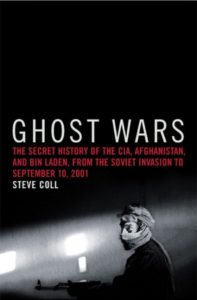
view/request
This very readable history of why and how we got involved in the mess of competing tribes and loyalties that is Afghanistan explained in short, digestible chapters each detailing an event or a person. The long chain of events that led to September 11 and the failure of intelligence services is enlightening if grim reading. This writer will be interested in the author’s sequel to see if we’ve learned anything at all.
Reviewed by Linda
Tagged: History, Non-fiction

view/request
On March 21, 2020, Sandi Toksvig posted a video on a new YouTube, Vox Tox. It opens with the calming sound of a slow piano rag and a view of Sandi Toksvig in a rocking chair, a book in her lap, a dog at her feet, a fireplace to her side, and bookcases full of books behind. The camera pans over some of Sandi’s books before cutting back to Sandi, who looks into the camera and begins, “Hello there. Come have a sit down.” She continues:
You know we’re in strange times and I do know that there are some people are feeling a tad isolated, so I thought we could just have a bit of a chat. When I’m at home, I’ll be honest with you, I’m quite quiet, and a bit private, but I would like to invite you into my favorite room in our house: it’s one, as you can see, with all the books. When things are taking a bit of a low turn, which they do for everybody at some point, this is the place I come to find a bit of calm. I think we all need to find the positive in this enforced separation from the world and the bit I’m finding is how lovely to have the time to dip in and out of some ancient volume I haven’t looked at for ages. I struggled a great deal with loneliness when I was a child and it was always books which kept me company.
Vox Tox is “a daily amble through the library of Sandi Toksvig”. It’s also a wonderful amble through the mind of Sandi Toksvig, whose interests are wide ranging. The bulk of each episode, which is just under ten minutes long, consist of various historical stories with an emphasis on the stories of women, and no fear of digression. Sandi’s style is wonderfully conversational, and her manner wonderfully calming, like a Mr. Rodgers for gown ups. There has been a new Vox Tox each day, and I highly recommend subscribing to the channel.
Reviewed by Ben
Tagged: England, History, Online Video
Gastropod
by Cynthia Graber and Nicola Twilley
[Online Resource]

view/request
Cynthia Graber and Nicola Twilley host a delightful podcast that explores food through the lens of science and history. They explore the origins of foods (who really did invent the French Fry?), the biology of foods (what causes the differences between different sourdoughs?), the psychology of food (how do menus affect what we order?), the ecology of food (how can our food choices affect invasive species or the climate?). They explore unusual foods (the pawpaw, kelp, and kombucha) and common foods (butter, bread, salt, and beer) and everything in between. Most episodes are about 40 minutes long.
All the episodes are great, but my favorites include:
Reviewed by Ben
Tagged: Cooking, Food, History, Podcast
Crash Course World History
by John Green
[Online Resource]

view/request
Library users may know John Green best as the author of such popular books as The Fault in Our Stars and An Abundance of Katherines, but he is also a prolific YouTube content creator. His Crash Course series is, so I’m told, aimed at teens, but is loved by adults as well. I am particularly fond of Crash Course History.
Crash Course History was the first series in the Crash Course brand and every episode consists of a short presentation by Green enhanced with clever animations. Green’s style is conversational and engaging. He treats us to occasional tangents and jokes, but the content remains focused and extremely informative, and he doesn’t shy away from difficult topics like imperialism, fascism, and slavery.
Each episode is just over ten minutes long. The length is appropriate for an easily digestible summary that leaves you curious and interested to learn more about a topic. Episodes include The Agricultural Revolution, The Silk Road and Ancient Trade, Mansa Musa and Islam in Africa, and The Columbian Exchange and 38 other topics from ancient through modern times.
Other series in Crash Course brand include, among others, English Literature, Philosophy, Economics, and U.S. History, and more are being planned. You can find them all at the Crash Course page on YouTube.

Reviewed by Ben
Tagged: Educational, History, Non-fiction, Online Video, TV series
Lives Worth Living
[DVD]
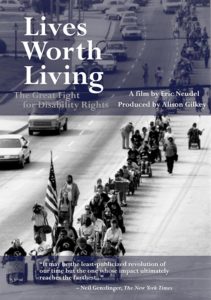
view/request
When I went to the Northampton Senior Center for a special Northampton Commission on Disability screening of Lives Worth Living I didn’t know anything about the film or its subject the disability rights movements. I was pleasantly surprised to find that the film was not just informative, but a well-crafted and incredibly moving introduction to the subject that left me eager to learn more.
At just 54 minutes in length, Lives Worth Living is too short to be more than an introduction to the story of disability rights (which it traces from the polio epidemics of the early twentieth century and the treatment of disabled veterans up to the passage of the Americans With Disabilities Act of 1990), but it makes excellent use of the time it has. We briefly learn about the discrimination and negative attitudes faced by the people with disabilities who were too often assumed to be without potential or worth. We briefly learn about the shocking maltreatment of people with mental disorders and about the Willowbrook State School and the abuses that occurred there and at similar institutions throughout the country. We learn about the Architectural Barriers Act of 1968, the Rehabilitation Act of 1973, and other early legislation, but more importantly we learn about the advocates who pushed to expand protections for the disabled, unifying diverse groups (associations for the blind, the physically handicapped, mental patients and others), and how disability rights became recognized as civil rights. And we learn about the protesters—the individuals who occupied buildings, locked themselves to bus shelters, and even crawled and pulled their way up the capitol steps to make their message heard.
Lives Worth Moving is a powerful film, well worth watching and relevant to us all. I cannot recommend it enough.
Reviewed by Ben
Tagged: Civil rights, Disability, Documentary, Film, History
The Ukrainian and Russian Notebooks
[Graphic Novel]
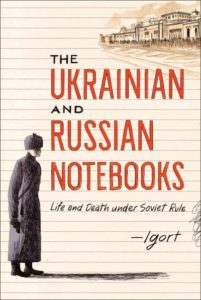
view/request
New graphic nonfiction by Italian comics artist Igort!
Over the past few decades only a small handful of Igort’s work have been translated into English, despite his status as an award winning graphic novelist and the founder of esteemed publishing house Coconino Press, so a new arrival of his to our shores is always a reason for excitement.
For his newest graphic novel Igort spent two years in Ukraine and Russia collecting stories from survivors and witnesses of life under Soviet rule. Focusing on the government sanctioned famine of 1932, and the assassination in 2006 of journalist and human rights activist Anna Politkovskaya, this collection of deeply affecting interviews is rendered in Igort’s stark yet compassionate illustrative style. A single opening panel just telling the year can pack as much emotion and connotative information as some other artist’s entire novels, simply through his layering of images and line work — a true master of the craft.
Definitely not an easy read in terms of its direct depictions of human atrocities, but certainly one of the most important graphic novels of the year, humanizing events that have mostly been told through a skewed western lens, while also connecting current turmoil in the region to its tumultuous past, helping create a more complete and honest history.
Reviewed by Josh
Tagged: Comics, Graphic nonfiction, History
Hidden
by Loïc Dauvillier
[Graphic Novel]

view/request
Memories of being hidden, and keeping those memories hidden… A grandmother tells a special story from her childhood in this touching graphic novel about being young during World War II.
Douina’s lives with her mother and father in Paris. Her life is relatively normal until she is made to wear a star on her jacket. Her father had told her it was a sheriff’s star but everyone begins to treat her differently. Soon her parents are taken away to work camps and Douina is left to be cared for by neighbors and kind strangers. As she settles into her new life and new name, Simone, she can’t help but miss her mother and father. Once the war has ended and it is safe again, she travels back home and begins the search for her parents.
This book offers children a glimpse into the past- what it was like to be young during WWII and how some children and families were affected by the Holocaust in France. Words by Loïc Dauvillier and art by Marc Lizano and Greg Salsedo
Reviewed by Ellen
Tagged: Families, History, Memoir, World War II
The Big Burn: Teddy Roosevelt and the Fire That Saved America
by Timothy Egan
[Book]
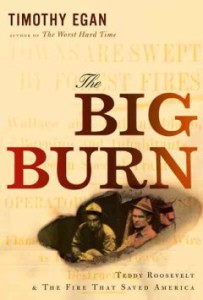
view/request
What does a fire in the Bitterroots have to do with Teddy Roosevelt and the Forest Service? The Forest Service was started by Teddy Roosevelt and Gifford Pinchot, the first chief of the USFS, in 1905. However, many politicians wanted to sell off the forests to large corporations, and thought conservation was a horrible idea. That might sound familiar, but this was at the beginning of the 20th century. A huge fire in 1910 was the catalyst to prevent this new agency from being blown away. Interesting look at the politics of the time, and an adrenaline-inducing account of the front lines of the fire. This book is a coming-of-age story for the United States Forest Service.
Reviewed by Molly
Tagged: History, Non-fiction
Midnight in Peking
by Paul French
[Book]
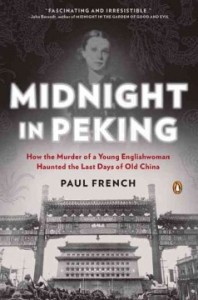
view/request
In 1937 foreigners and native Beijinger’s alike were shocked when the mutilated body of a young woman was found just outside of of Beijing’s Legation Quarter. Clearly, a terrible crime had been committed, but what had happened? The investigation was complicated by the bureaucratic system that made it difficult for law enforcement in the Legation Quarter and in Chinese Beijing to work together and the detectives in charge of the case struggled with a lack of information and communication—and what seemed all too often to be pure obstructionism from above. Paul French’s Midnight in Peking offers a fascinating glimpse of China at beginning of the Second World War, a time when powerful Europeans were leaving China, and many refugees were arriving in Beijing and nearby cities, fleeing from the USSR and Nazi Germany, and from the increasingly hostile and militaristic presence of the Japanese within China.
French’s narrative follows both the official investigations, and the unofficial investigation conducted by the victim’s father. There are some surprising twists along the way, and French takes advantage of them to keep the reader on her toes. An engaging read, but not for the squeamish or those who prefer to read stories in which justice is fulfilled.
Reviewed by Ben
Tagged: China, History, Non-fiction, True crime
Winter in Wartime
[Blu-ray, DVD]
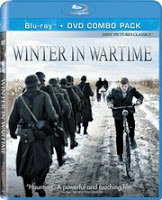
view/request
This beautifully shot period film follows 13 year old Michiel, a small town boy in Nazi-occupied Holland in the Winter of 1945. Michiel’s childhood innocence and restless desire for adventure lead him into increasingly dark and morally ambiguous territories when the realities of war, resistance and adulthood collide and converge upon his small town life. He is apprehensive about his father’s uneasy cooperation with their German occupiers and looks up to his uncle Ben, a resistance fighter whose connections, gifts and attitude intrigue Michiel. When an allied fighter pilot crashes near the village, Michiel and his sister, a young nurse, are drawn into the search for the pilot and must debate whether to take action or remain silent, and question who they can truly trust. The film, while somewhat conventional in some of its WWII era plotlines, offers enough twists and intrigue to keep the viewer’s attention, but its real appeal is grounded heavily in the films setting. The scenes are filmed beautifully and the village, woods, snow, bicycles, knitwear and natural light combine to give the film an enchanting sense of place, and ground the viewer in Michiel’s conflicted world, caught between action and fear, occupation and resistance and childhood innocence and the risks of adult responsibilities. This film is one of several Forbes films now added in Blu-Ray and DVD (both discs are included in one case, so patrons will not mistakenly get home and find the film unplayable), and the Blu-Ray is especially recommended for its crisp picture, which captures the film’s setting wonderfully.
Reviewed by Dylan
Tagged: Drama, Feature film, Foreign film, Historical fiction, History













